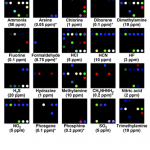colour
Artist Mike Bodge has unveiled a nifty project to chart the colour of the sky above New York City in real time. A camera installed in his office snaps a picture of the skyline every five minutes, and analyses the image to calculate its average colour. The varying shades of blue, grey, orange and black are posted online in a never-ending mosaic.
Mike says:
Many of my projects tend to be about New York City, as it's a place i'm constantly inspired by. I have a great view at my office overlooking the East Village neighborhood and I've done time lapses and other things but none really…
Researchers at the University of Illinois, Urbana-Champaign have developed a way to compare aromas visually using specially developed inks.
Kenneth Suslick and his colleagues used tiny squares of polymer film that hold 36 drops of carefully designed dyes. These pigments change colour when exposed to various chemicals. The result is a cheap system for detecting very low concentrations of gaseous compounds. The cards can be used like a physicist's radiation dose badge to alert lab workers when they have been exposed to toxic gases.
As shown above, the cards can be used to give each…
National Geographic should have a 3-D animation up soon
The pursuit of accurate dinosaur colours just turned into a race, and a heated one at that. Just last week, I wrote about a group of scientists who claimed to have accurately identified the colours of some feathered dinosaurs by microscopically analysing three fossils. According to that study, Sinosauropteryx had a tail covered in ginger stripes. Now, another group have revealed the palette of an entire dinosaur, Anchiornis. This tiny predator had a dark grey body and the limbs bore long, white feathers tipped with black spangles. Its…
"That is Shadowfax. He is chief of the Maeras, lords of all horses, and not even Theoden, King of Rohan, has ever looked on a better. Does he not shine like silver, and run as smoothly as a swift stream?" - Gandalf
In the Lord of the Rings, Gandalf rides upon a magnificent white stallion called Shadowfax. White horses have been greatly prized in human societies as a sign of wealth and dignity, largely because their bright coats are both pretty and rare. There are reasons for that. In the wild, the same conspicuousness that inspires legendary tales also makes white horses vulnerable to…
Dinosaur books have become more colourful affairs of late, with the dull greens, browns and greys of yesteryear replaced by vivid hues, stripes and patterns. This has largely been a question of artistic licence. While fossils may constrain an artist's hand in terms of size and shape, they haven't provided any information about colour. But that is starting to change.
The fossils of some small meat-eating dinosaurs were covered in filaments that are widely thought to be the precursors of feathers. And among these filaments, a team of Chinese and British scientists have found the distinctive…
In the White Sands National Park of New Mexico, there are three species of small lizard that all share white complexions. In the dark soil of the surrounding landscapes, all three lizards wear coloured coats with an array of hues, stripes and spots. Colours would make them stand out like a beacon among the white sands so natural selection has bleached their skins. Within the last few thousand years, the lesser earless lizard, the eastern fence lizard and the little striped whiptail have all evolved white forms that camouflage beautifully among the white dunes.
Erica Bree Rosenblum…
Walk through the rainforests of Ecuador and you might encounter a beautiful butterfly called Heliconius cydno. It's extremely varied in its colours. Even among one subspecies, H.cydno alithea, you can find individuals with white wingbands and those with yellow. Despite their different hues, they are still the same species... but probably not for much longer.
Even though the two forms are genetically similar and live in the same area, Nicola Chamberlain from Harvard University has found that one of them - the yellow version - has developed a preference for mating with butterflies of its own…
The most incredible eyes in the animal world can be found under the sea, on the head of the mantis shrimps. Each eye can move independently and can focus on object with three different areas, giving the mantis shrimp "trinocular vision". While we see in three colours, they see in twelve, and they can tune individual light-sensitive cells depending on local light levels. They can even see a special type of light - 'circularly polarised light' - that no other animal can.
But Nicholas Roberts from the University of Bristol has found a new twist to the mantis shrimp's eye. It contains a…
Many living things, from chameleons to fish to squid, have the ability to change their colour. But flowers? Yes, over 450 species of flower have the ability to shapeshift, altering their colour and positions over the course of a day. The goal, as with many aspects of a flower's nature, is communication. The secondary palette tells pollinators that a particular flower has already been visited and not only needs no pollen but has little nectar to offer as a reward. The visitor's attentions (and the pollen it carries) are directed towards needier flowers.
The legume Desmodium setigerum is one…
For many of us, the most memorable bits of school chemistry classes were lessons where we ignited metal salts over a Bunsen burner to produce brightly coloured flames, from the lilac of potassium to the distinctive red of lithium. Now a group of chemists from Harvard University have found a way of using these colourful flames to transmit coded information.
Working in the lab of legendary chemist George Whitesides, Samuel Thomas III has developed the 'infofuse', a strip of flammable paper patterned with metal salts. As the strip burns, the metals change the colour of the flames, creating…
Autumn is a time of incredible beauty, when the world becomes painted in the red, orange and yelllow palette of falling leaves. But there may be a deeper purpose to these colours, and the red ones in particular. In the eyes of some scientists, they aren't just decay made pretty - they are a tree's way of communicating with aphids and other insects that would make a meal of it. The message is simple: "I am strong. Don't try it."
During winter, trees withdraw the green chlorophyll from their leaves, and textbooks typically say that autumn colours are produced by the pigments that are left…
Having trouble with a word puzzle? Suffering from writer's block? Perhaps you're not looking at the right colour...
We encounter many of the colours in our lives under the same circumstances and as a result, we have come to associate certain colours with specific attributes. Red invokes thoughts of action, danger or mistakes because it is a common feature of warning signs and editorial ink. Blue, however, is a more soothing hue, and its presence in both sky and sea have connected it to peace and openness.
These associations aren't trivial ones - they can affect the way we think. In a clever…

